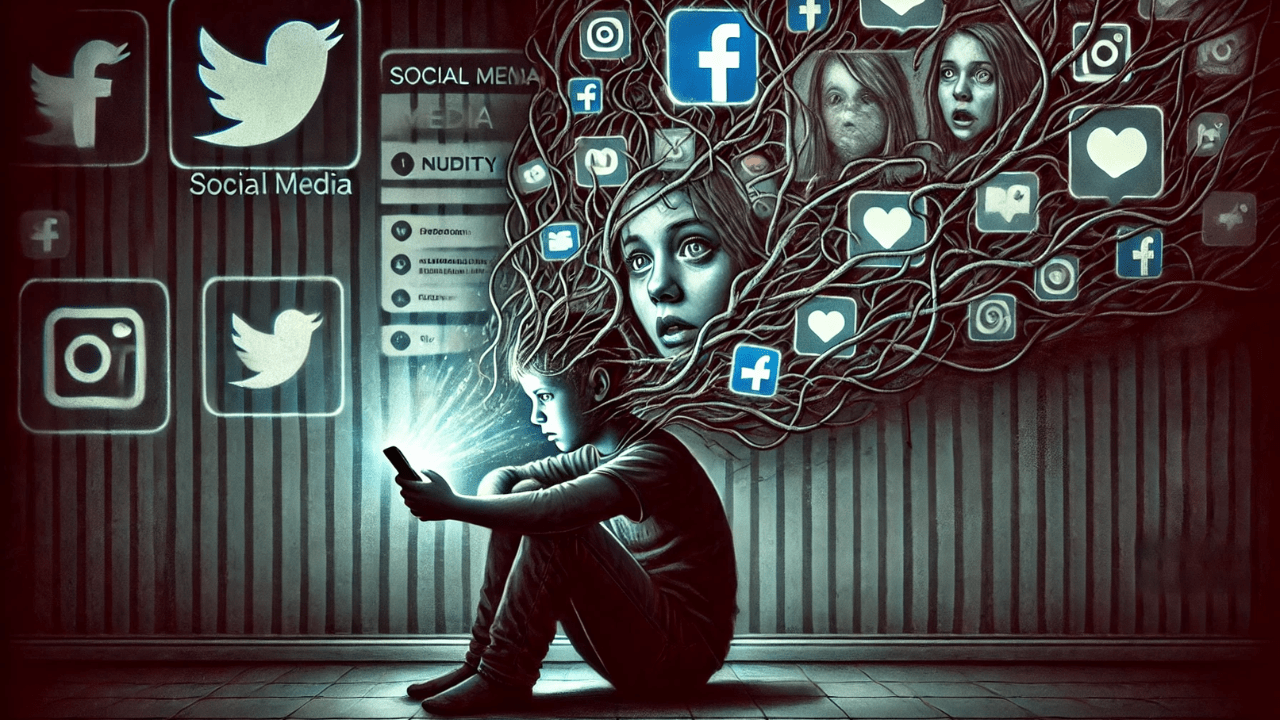Understanding how social media nudity is impacting the youth and their future potential. Learn about the risks of unregulated content, cultural sensitivities, and solutions for protecting young minds!

In today’s interconnected world, social media has revolutionized how we communicate, learn, and express ourselves. While platforms like Instagram, TikTok, Twitter, and many more have provided countless benefits, they have also introduced new challenges. Among these is the growing prevalence of nudity, which poses a significant threat to the younger generation’s development and potential.
Unregulated nudity on social media can have profound psychological, social, and cultural consequences for youth. It distorts self-perception, fosters unhealthy societal norms, and can even lead to exploitation. Understanding the scope of this issue and identifying actionable solutions is critical to safeguarding our youth and empowering them to thrive in a digital age.
The Rise of Social Media Nudity
Social media platforms were originally created to foster connections and share ideas. However, over the years, they have evolved into spaces where individuals showcase their lifestyles, opinions, and creative works. While this inclusivity is commendable, it has also blurred boundaries, leading to the normalization of nudity and explicit content.
Content creators often push the limits of acceptability to gain attention, likes, and followers. For many, nudity has become a tool for achieving virality and standing out in an oversaturated digital space. This trend not only affects adults but also trickles down to impressionable teenagers and young adults who are active users of these platforms.
Unfortunately, the algorithms of social media platforms often amplify such content. Posts with higher engagement are promoted to larger audiences, exposing even those who may not actively seek explicit material. This unintentional exposure can profoundly impact the mental and emotional well-being of young users.
Impact of Social Media on Youth Development
The developmental stage of adolescence and early adulthood is marked by curiosity, vulnerability, and a quest for identity. Exposure to unregulated nudity during this phase can have lasting consequences, including:
1. Distorted Body Image
Social media often showcases curated and filtered images that create unrealistic beauty standards. The constant exposure to these images can lead young individuals to feel inadequate or dissatisfied with their own appearance. This dissatisfaction is a major contributing factor to anxiety, depression, and eating disorders.
2. Objectification and Sexualization
Frequent exposure to explicit content can normalize the objectification of individuals, making young people equate their worth with their physical appearance. This mindset can perpetuate harmful behaviors and attitudes, including low self-esteem and unhealthy relationships.
3. Distracted Focus
Instead of focusing on academic growth, personal development, or career-building activities, many young individuals become consumed by the superficial world of social media validation. The constant pressure to conform to trends and gain social approval can distract them from achieving long-term goals.
4. Emotional Desensitization
Repeated exposure to nudity and explicit material can desensitize individuals, making them more accepting of inappropriate content. Over time, this normalization can reduce empathy and sensitivity to issues like exploitation or harassment.
The Risk of Exploitation and Cyberbullying
Unregulated nudity also opens the door to darker issues like exploitation and cyberbullying. Predators, scammers, and cyberbullies often use social media to target vulnerable individuals. Some of the dangers include:
1. Sextortion and Revenge Porn
Cases of sextortion, where individuals are blackmailed using explicit images or videos, are alarmingly common. Revenge porn—sharing explicit content without consent—is another form of abuse that leaves victims emotionally scarred and socially ostracized.
2. Online Harassment
Youth engaging with or sharing explicit content may become targets of online harassment. Hateful comments, body shaming, and public humiliation can have devastating effects on their mental health.
3. Exposure of Minors to Inappropriate Content
Despite age restrictions, minors often gain access to platforms where explicit content is prevalent. This early exposure can influence their perceptions of relationships, consent, and self-worth in unhealthy ways.

Cultural Sensitivities and Global Perspectives
The issue of social media nudity is further complicated by cultural differences. In some societies, nudity is considered a form of artistic or personal expression, while in others, it is deemed highly inappropriate.
In conservative cultures, the prevalence of nudity on social media can clash with societal values, leading to stigma and family conflicts for individuals who engage with or are exposed to such content. On the other hand, in liberal societies, the lack of regulation can result in unchecked exploitation or misuse.
This cultural dichotomy highlights the need for social media platforms to adopt context-sensitive moderation policies that respect diverse values while prioritizing user safety.
The Role of Social Media Platforms
Social media platforms bear significant responsibility for the content shared on their networks. While most platforms have community guidelines to address nudity and explicit material, enforcement remains inconsistent.
1. Inadequate Moderation
With billions of users globally, manually moderating content is nearly impossible. As a result, platforms rely on artificial intelligence (AI) algorithms to detect and remove inappropriate material. However, these algorithms often fail to differentiate between artistic expression and harmful content, leading to both over-censorship and under-censorship.
2. Poor Age Verification Systems
Many platforms require users to self-report their age, making it easy for minors to bypass restrictions. Without robust age verification measures, explicit content continues to reach underage users.
Solutions to the Problem
Addressing the issue of social media nudity requires a multi-faceted approach involving platforms, policymakers, educators, and parents.
- Enhanced Content Moderation
Social media companies must invest in more advanced AI tools capable of identifying harmful content with greater accuracy. Combining AI with human oversight can ensure a balanced approach to moderation. - Strict Age Verification
Implementing robust age verification systems—such as government ID checks—can help restrict access to explicit content for minors. - Parental Controls
Platforms should offer enhanced parental controls that allow guardians to monitor and limit the type of content their children can access. - Awareness Campaigns
Educating the youth about the dangers of sharing and consuming explicit content is crucial. Schools, community organizations, and governments should collaborate to promote digital literacy and safe online practices. - Reporting and Accountability
Encouraging users to report inappropriate content and ensuring timely responses from platforms can help create a safer online environment.
How Parents and Guardians Can Help
Parents and guardians are vital in protecting children from the negative effects of social media nudity. Here are some actionable steps they can take:
- Open Communication: Encourage honest discussions about the risks of social media and the importance of personal boundaries.
- Set Screen Time Limits: Monitor and limit the amount of time children spend on social media to reduce exposure to harmful content.
- Use Parental Control Apps: Utilize tools that filter content and monitor social media activity.
- Promote Self-Esteem: Encourage children to develop confidence based on their talents, values, and achievements rather than their appearance or social media validation.
Final Thoughts
Social media nudity is a pressing issue that demands urgent attention from all stakeholders. While social media platforms have revolutionized communication and creativity, their unregulated aspects pose significant risks to youth development and safety.
By implementing stricter content moderation policies, enhancing digital literacy, and fostering open communication, we can mitigate these risks and create a safer, more empowering digital space. Protecting the youth from the harmful effects of social media nudity is not just a moral obligation—it is an investment in their future potential. Let us work together to ensure that social media remains a platform for positive growth and meaningful connections.
Read More

The Psychology of Love: Why Valentines Day Matters More Epic Than You Think
Discover the psychology of love and why Valentines Day is more important than you think. Learn how love impacts the brain, strengthens relationships, and boosts

Premier League Highlights: Arsenal Humiliate Man City 5-1, Spurs and Palace Secure Crucial Wins
Arsenal demolished Manchester City 5-1 in a statement premier league highlights win, reigniting their title hopes. Meanwhile, Crystal Palace stunned Man United 2-0, and Tottenham

How Budget 2025 Impacts the Indian Middle-Class: Major Tax Benefits and Glaring Omissions
Budget 2025 offers major tax relief to the middle class, including zero tax on incomes up to ₹12 lakh. However, it misses out on incentives

Degrees vs Employability: Why “Highly Qualified Degree Holders” Struggle to Find Jobs While “Less Qualified Individuals” Get Hired Faster!
Many highly qualified individuals struggle to secure jobs, while less qualified candidates get hired quickly. This Degrees vs Employability paradox is caused by employer preferences,

The Power of Mindset: Why Looking Poor Doesn’t Make You Poor, but Thinking Poor Does!
Discover why looking poor doesn’t define your wealth but thinking poor does. Learn the power of mindset and how a growth-oriented mindset can lead to

Overthinking: How It’s Damaging Today’s Youth – Causes and Cure in 2025
Understanding how overthinking is silently damaging today’s youth, from its causes rooted in societal pressure and social media to its long-term effects on mental health.
